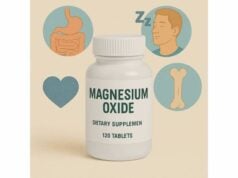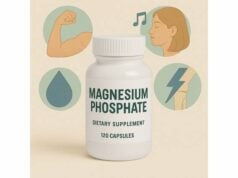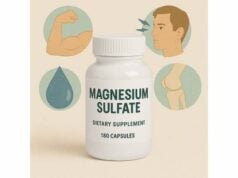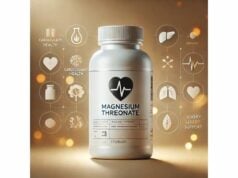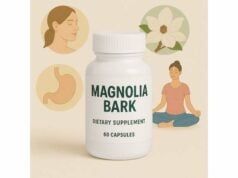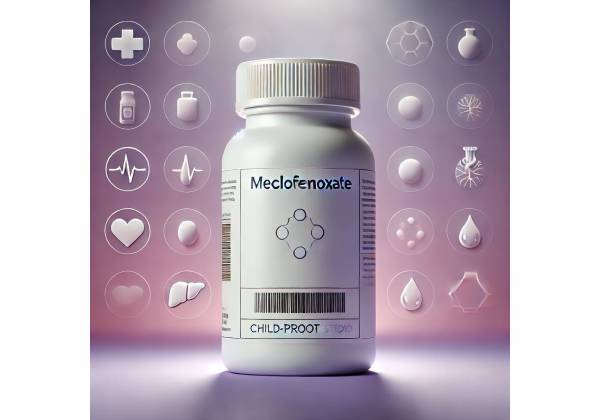
Meclofenoxate—better known by its older name, centrophenoxine—is a cholinergic nootropic used for decades in Europe and parts of Asia. It combines DMAE (dimethylaminoethanol) with p-chlorophenoxyacetic acid to form a salt that crosses the blood–brain barrier more readily than DMAE alone. People explore it for age-related memory complaints, post-illness mental fatigue, and general cognitive support. In cells and animal models, meclofenoxate appears to support acetylcholine signaling, improve membrane phospholipid turnover, and counter lipid peroxidation, with historical studies also linking it to lipofuscin clearance—a pigment that accumulates with aging. Human evidence is mixed and often older, yet recent laboratory research has renewed interest by showing gene-expression shifts in aging brains and neuroprotective signals in disease models.
This guide takes a practical, evidence-aware approach. You will find what meclofenoxate is and how it works, who might consider it (and who should not), suggested dosage ranges and timing, safety watch-outs, and what the latest research does—and does not—show. If you decide to discuss it with your clinician, you will be ready with clear, specific questions.
Quick Overview
- May support attention and short-term memory in older adults and reduce mental fatigue in some users.
- Typical oral dose is 500–1,500 mg/day, split into 2–3 doses; some trials used up to 2,000 mg/day.
- Avoid late-day dosing to reduce insomnia or overstimulation risk.
- Not for pregnancy, breastfeeding, untreated bipolar disorder, or anyone on strong cholinergic/anticholinergic drugs without medical supervision.
Table of Contents
- What is meclofenoxate and how it works
- Evidence-backed benefits and limitations
- How to use meclofenoxate correctly
- Meclofenoxate dosage, timing, and cycling
- Side effects, interactions, and who should avoid
- What the research says today
What is meclofenoxate and how it works
Meclofenoxate (centrophenoxine) is a synthetic ester formed by binding DMAE—a choline analog—to p-chlorophenoxyacetic acid (p-CPA). The pairing increases lipophilicity and brain availability compared with DMAE alone. After oral intake, the molecule is absorbed in the gut, circulates, and splits into its components. In the brain, the DMAE portion acts as a cholinergic donor, supporting the synthesis of acetylcholine, a neurotransmitter central to attention, learning, and short-term memory encoding. The p-CPA moiety is mostly excreted in urine.
Beyond cholinergic support, meclofenoxate shows two mechanisms that make it different from many “stimulant-like” enhancers:
- Membrane phospholipid turnover: Neurons rely on a steady supply of phosphatidylcholine and other phospholipids to maintain membrane integrity, synaptic vesicle formation, and plasticity. Laboratory work suggests meclofenoxate can increase phospholipid synthesis and accelerate repair of membranes under oxidative stress. In practice, people sometimes describe a steadier mental energy rather than a “rush” because this pathway is metabolic, not purely excitatory.
- Cellular housekeeping and oxidative resilience: Oxidative stress and peroxidized lipids can accumulate with age, contributing to lipofuscin deposits in long-lived cells. Classic microscopy studies reported that meclofenoxate reduces lipofuscin burden in aged tissues. More recently, whole-brain transcriptomic studies in short-lived fish models show shifts in genes linked to mitochondrial function, lipid metabolism, and synaptic signaling after meclofenoxate, consistent with a broader neuroprotective program rather than a single-receptor effect.
A practical implication is that meclofenoxate does not work like caffeine or amphetamine. Many users do not feel much from one capsule. Benefits—if they occur—tend to build over days to weeks, particularly in people with low cholinergic tone (for example, older adults or those with fatigue after illness). Because acetylcholine drives arousal and memory encoding, some individuals experience light overstimulation at first (busy mind, jaw tension, headache). Starting at the low end of the range and avoiding late-evening dosing usually solves this.
Finally, a regulatory note: meclofenoxate is not approved as a drug in many countries, and in sport it is treated as a prohibited stimulant in-competition. Supplement labels are not always accurate about content. If you are an athlete or subject to workplace testing, discuss this with your oversight team before use.
Evidence-backed benefits and limitations
Cognition and aging: Several double-blind trials from the 1960s–1990s tested meclofenoxate in older adults with benign memory complaints or mild cognitive impairment. Doses commonly ranged from 1,560–2,000 mg/day for 8–12 weeks. Outcomes varied: a portion of participants improved on memory subtests (especially tasks requiring consolidation of new information), while others showed little to no change. Methodological issues—small samples, mixed diagnostic categories, limited statistics—make firm conclusions difficult. The clearest pattern is that subjective alertness and energy improved more reliably than composite scores of global cognition, and that benefits, when present, were modest rather than dramatic.
Mental and physical fatigue: Clinicians sometimes tried meclofenoxate in convalescence and post-infectious fatigue. The logic is cholinergic support for attention plus membrane repair in tissues under oxidative stress. Evidence is mostly observational. Some users report reduced mental fog and easier word-finding after a week or two. Others feel no difference or experience mild agitation at higher doses.
Neuroprotection signals in models: In animal and cell studies, meclofenoxate has shown antioxidant, anti-lipoperoxidative, and mitochondria-supportive actions. In aged rodents, it has been used at 100 mg/kg in chronic protocols to evaluate synaptic ultrastructure, lipofuscin dynamics, and behavior. Newer work in disease models shows reduced neuronal loss, less lipid peroxidation, and improved behavioral readouts versus controls. While promising, these findings are preclinical; the relevance to humans remains a hypothesis until tested in rigorous trials.
Parkinson’s disease and other indications (early-stage research): Recent multi-omics drug-repurposing work identified meclofenoxate as a candidate neuroprotective agent, with follow-up mouse experiments suggesting functional benefits on motor behavior and cellular stress pathways. That is exciting for basic science, but not a treatment recommendation. It underscores that meclofenoxate’s main value today is as a putative metabolic and cholinergic support rather than a proven disease-modifying therapy.
Performance and sport: Even though the compound is not an amphetamine, governing bodies classify it under stimulants for in-competition purposes. The prohibition concerns potential performance enhancement and testing confounders (for example, metabolite overlaps). Practically, this means athletes should avoid it when competing.
Bottom line on benefits:
- Most consistent signals: mild improvements in alertness and attention, sometimes better memory consolidation in older adults; reduced subjective fatigue in some users.
- Uncertain or inconsistent: large, durable gains in overall cognition, especially in healthy young adults.
- Strongest lab-based effects: antioxidant and membrane-support actions; gene-expression shifts that favor neuronal resilience.
- Translational gap: modern, adequately powered randomized trials are lacking.
How to use meclofenoxate correctly
Choose a reliable form. Meclofenoxate is most often sold as meclofenoxate hydrochloride in tablets or capsules (commonly 200 mg per unit). In some regions it is a prescription medicine; in others, it appears in over-the-counter “nootropic” blends. Be aware that label accuracy varies, and independent analyses have found products with less or more active ingredient than declared. If you and your clinician decide to try it, opt for single-ingredient products from manufacturers that publish batch-level testing.
Start low, go slow. Because responses differ, begin at 250–300 mg once daily with breakfast for 3–4 days. If well tolerated, increase to 250–500 mg twice daily (breakfast and early afternoon). Some historical protocols used 500 mg three times daily or 1,560–2,000 mg/day in older adults; those higher ranges should be used only under medical supervision.
Dose timing matters. Acetylcholine promotes alertness. Dosing after 3–4 p.m. can disrupt sleep in sensitive people. Morning and early-afternoon are the safest windows. If you notice jaw tension, restlessness, or a “wired” feeling, reduce the dose and move it earlier.
Hydration and nutrition. Cholinergic agents sometimes trigger tension headaches when people are dehydrated or low in electrolytes. Drink water, include magnesium-rich foods (leafy greens, nuts), and avoid stacking multiple stimulating compounds.
Do not mix casually with other cholinergics. Combining meclofenoxate with acetylcholinesterase inhibitors (for example, donepezil) or high-dose choline can amplify cholinergic side effects (nausea, sweating, bradycardia, vivid dreams). Such combinations require clinician oversight. Likewise, strong anticholinergic drugs (some antihistamines, bladder antispasmodics, certain antidepressants) can counteract the intended effect and complicate side-effect patterns.
Track outcomes you care about. Before starting, pick 2–3 metrics: e.g., sleep onset latency, word-finding ease, mid-afternoon mental stamina, or a short working-memory task you can repeat weekly. Give any change 10–14 days at a steady dose before judging. If you see no meaningful benefit or side effects persist, discontinue and review other options.
Know the context you are using it in.
- For post-illness brain fog or age-related memory complaints, the target is gentle cognitive support. Combine with sleep hygiene, exercise, anti-inflammatory diet, and stress management.
- For students or high-pressure deadlines, be cautious: meclofenoxate is not a motivation pill; over-doing the dose can backfire with anxiety or sleep loss.
- For athletes, because it is prohibited in-competition, the safest policy is avoidance when subject to testing.
Stop rules. If you develop persistent insomnia, palpitations, marked anxiety, skin rash, or GI upset that does not improve after dose reduction, stop and seek medical advice. Any sign of mood switching (elevated mood, decreased need for sleep, impulsivity) warrants immediate discontinuation.
Meclofenoxate dosage, timing, and cycling
Working range for adults (oral):
- Entry dose: 250–300 mg once daily with breakfast for 3–4 days.
- Typical functional range: 500–1,000 mg/day, usually split 250–500 mg twice daily (morning and early afternoon).
- Historically studied higher range: 1,560–2,000 mg/day in older adults under supervision, often for 8–12 weeks.
These ranges reflect published clinical protocols and contemporary practice patterns. If you are smaller-framed, medication-sensitive, or primarily seeking help with mental fatigue rather than memory complaints, you may do best at the low end.
Frequency and duration. Because perceived benefits build gradually for some, many protocols run 6–12 weeks before a full reassessment. For healthy users experimenting for productivity, a 30-day trial is a reasonable ceiling unless under clinician guidance. If continuing beyond 12 weeks, schedule drug holidays (for example, 5 days on, 2 days off weekly, or 3 weeks on, 1 week off) to evaluate whether effects persist and to reduce tolerance.
Timing tips.
- Take the first dose with food in the morning to reduce nausea.
- A second dose can be taken 4–6 hours later, not past mid-afternoon.
- Avoid combining with strong stimulants on the same day until you know your response; synergy may feel jittery.
Special populations.
- Older adults: Often respond at moderate doses. Start at 250 mg once daily, titrate slowly, and monitor blood pressure, sleep, and GI tolerance.
- Liver or kidney impairment: Use medical supervision; dosage may need to be lower and lab monitoring may be appropriate.
- Pregnancy and lactation: Do not use. Safety is not established.
- Athletes in drug-tested sports: Treat as off-limits in-competition because of prohibited status and potential metabolite detection.
Stacking and synergies (advanced; clinician input recommended):
- With omega-3 (DHA) and B-complex, meclofenoxate’s membrane and methylation demands are supported nutritionally.
- With L-theanine or magnesium glycinate, overstimulation risk may be reduced.
- Avoid stacking with multiple cholinergics (for example, huperzine A, high-dose CDP-choline) unless a clinician is steering the plan.
When to taper instead of stopping abruptly. Meclofenoxate is not physically addictive, but if you are taking ≥1,000 mg/day and feel distinctly more stimulated, reduce by 250–500 mg every 3–4 days to watch for rebound fatigue or irritability. Most users can stop without issues.
Side effects, interactions, and who should avoid
Common, usually mild (dose-related):
- Headache or jaw tension (often improves with hydration, magnesium, or lowering dose).
- Nausea or abdominal discomfort (take with food; split doses).
- Insomnia or vivid dreams (avoid late dosing).
- Restlessness or anxiety (reduce dose; consider adding calming sleep hygiene).
Less common:
- Skin rash or flushing.
- Palpitations in sensitive users.
- Mild blood-pressure changes (monitor if you have hypertension or are on antihypertensives).
Interactions to keep on the radar:
- Cholinesterase inhibitors (donepezil, rivastigmine, galantamine): potential additive cholinergic effects (nausea, bradycardia). Use only under specialist care.
- Anticholinergic medications (some antihistamines, tricyclics, bladder antispasmodics): may counteract benefits and increase side-effect unpredictability.
- Stimulants (prescription or high-dose caffeine): risk of overstimulation, anxiety, and sleep disruption.
- MAO inhibitors or complicated psychiatric regimens: consult a psychiatrist to avoid mood destabilization.
Who should not use meclofenoxate:
- Pregnant or breastfeeding individuals.
- Children and adolescents unless specifically prescribed by a physician.
- People with bipolar disorder unless closely supervised; cholinergic agents can precipitate mood shifts.
- Individuals with uncontrolled arrhythmias or significant cardiac disease without cardiology input.
- Athletes competing under anti-doping rules during in-competition periods.
Quality and contamination concerns: Surveys of commercial “brain” supplements have found undisclosed or inaccurate drug content in a subset of products. That matters for both safety and doping control. Favor single-compound products with third-party testing and avoid multi-ingredient proprietary blends where meclofenoxate appears alongside multiple stimulants.
If something goes wrong: Stop the product. For hives, swelling, chest pain, severe anxiety, or fainting, seek urgent care. For persistent insomnia or GI distress, a simple washout typically resolves symptoms over 24–72 hours.
What the research says today
The classic story. In the late twentieth century, clinicians explored meclofenoxate in age-related memory complaints, post-traumatic states, and psychoorganic syndromes. Several randomized, double-blind trials reported signal-level benefits on specific memory domains and subjective alertness, typically over 8–12 weeks at 1.5–2.0 g/day. However, small sample sizes and limited statistical rigor reduce confidence in broad claims. A conservative take is that meclofenoxate may help some older adults modestly, especially on memory consolidation and fatigue.
Modern translational work. The last few years brought a renaissance of preclinical research using “multi-omics” screening, model organisms, and refined behavioral assays:
- Transcriptomics in aging brain: Work in short-lived fish showed gene-expression changes after meclofenoxate consistent with improved lipid handling, mitochondrial resilience, and synaptic function.
- Neurodegeneration models: Mouse studies using integrative bioinformatics identified meclofenoxate as a candidate neuroprotective agent. Follow-up experiments suggested reduced lipid peroxidation, preserved mitochondria, and behavioral improvements.
Pharmacokinetics and form factors. Bioequivalence studies using 200 mg capsule and tablet formulations confirm reliable absorption with standard oral dosing in healthy adults. Clinical protocols typically split the daily total into 2–3 doses, consistent with user reports that twice-daily offers a good balance between effect and sleep.
Regulatory and sport status. Meclofenoxate is not an FDA-approved drug in the United States; in some countries it is a prescription medicine for certain indications. In anti-doping frameworks, it appears under stimulants prohibited in competition; athletes and support staff should treat it accordingly.
Data gaps to keep in mind:
- Few modern randomized trials in well-defined patient groups or healthy adults.
- Sparse head-to-head comparisons versus other cholinergics.
- Limited long-term safety data beyond several months of use in older literature.
- Product quality variability in the supplement market.
What a measured plan looks like now: If you and your clinician decide to test meclofenoxate, use a time-boxed trial (for example, 6–8 weeks) with clear outcomes, stick to 500–1,000 mg/day in split doses, and stop if sleep, mood, or anxiety worsens. Pair with foundational brain health strategies (sleep, exercise, nutrition, light exposure). If you are an athlete or in a compliance-sensitive role, choose other options.
References
- The Effect of Meclofenoxate on the Transcriptome of Aging Brain of Nothobranchius guentheri Annual Killifish 2022 (Preclinical)
- Repurposing the memory-promoting meclofenoxate hydrochloride as a treatment for Parkinson’s disease through integrative multi-omics analysis 2025 (Preclinical)
- Bioequivalence and pharmacokinetic comparison of a single 200-mg dose of meclofenoxate hydrochloride capsule and tablet formulations in healthy Chinese adult male volunteers: a randomized sequence, open-label, two-period crossover study 2008 (PK/BE)
- What Do Athletes Need to Know About Meclofenoxate? 2023 (Anti-doping Advisory)
- The differential effects of meclofenoxate on memory loss in the elderly 1977 (RCT, Older Adults)
Medical Disclaimer
This information is educational and not a substitute for personalized medical advice, diagnosis, or treatment. Meclofenoxate can interact with medications and may be inappropriate for certain conditions. Always consult a qualified healthcare professional before starting, stopping, or changing any supplement or medication. If you experience concerning symptoms, seek medical care promptly.
If you found this guide useful, consider sharing it with a friend or colleague on Facebook, X (formerly Twitter), or your favorite platform, and follow us for future evidence-based health articles. Your support helps us keep producing high-quality content.

